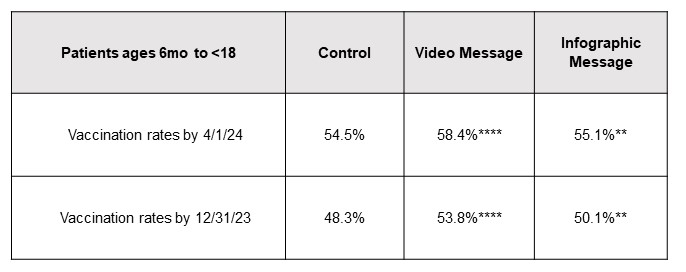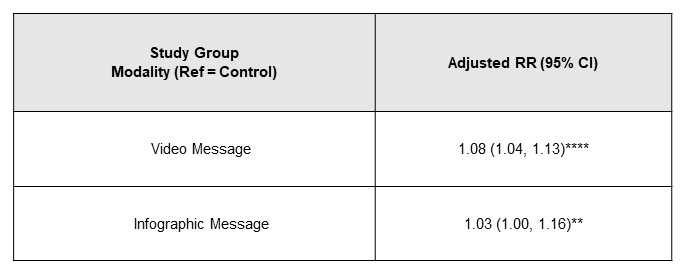Back
Background: Influenza (flu) vaccination rates remain low in children and have decreased following the COVID-19 pandemic. The impact of parent reminders for pediatric flu vaccinations appears to be waning, with many studies finding no impact of auto dialer, phone, mail, or text reminders. Yet, physicians and nurses are still the most trusted messengers for health information, including vaccines.
Objective: Evaluate the impact of patient portal-based messages with a physician-recorded video or an infographic on pediatric flu vaccination rates using a 3-arm RCT.
Design/Methods: We report on the pediatric portion of a larger 3-arm RCT conducted at UCLA primary care (10/3/2023 to 4/1/2024). Patients attributed to participating physicians (Pediatric, FM, Med-Peds) were randomized to receive 1) control, 2) video messages, or 3) infographic. Controls received standard-of-care messages. Parents (or adolescents >12yrs with portal access) in the video message arm were sent portal-based messages with an embedded video that was recorded by their physician encouraging them to get the flu vaccine. Physicians recorded videos themselves or via Zoom with the research team. Physicians were given a script but encouraged to personalize the content. Parents (or adolescents) in the infographic arm were sent portal-based messages with an embedded flu vaccine infographic with a photo of their physician. If no flu vaccine was noted in the EHR, 2 additional messages were sent to intervention arms. We used a mixed-effects Poisson regression models (clustering by provider) to assess effects of the interventions on flu vaccination rates by 4/1/2024 and earlier vaccination by 12/31/2023.
Results: 14 physicians participated with 3,200 patients < 19yrs (1,057 control; 1,058 video; 1,085 infographic). Vaccination rates at study completion (4/1/24) were significantly higher in both the video and infographic arms compared to control (Table 1). Adjusting for baseline demographics and prior flu vaccination, video messages increased flu vaccination rates compared to control by 3.9% (aRR 1.08 [1.04, 1.13], p< 0.001), and the infographics increased flu vaccination rates compared to control by 0.6% (aRR 1.03 [1.00, 1.16], p=0.04) (Table 2). Both interventions also improved earlier vaccination by 12/31/2023 (Table 1).
Conclusion(s): Physician-recorded videos and infographics delivered via the patient portal increased pediatric flu vaccination rates overall, and improved earlier vaccination. Physician-recorded video messages particularly show potential as an effective and scalable intervention capitalizing on trust for improving pediatric flu vaccination rates.
Table 1: Vaccination rates by study arm, as of 4/1/24 and 12/31/23.
 Asterisks indicate significance compared to controls, adjusting for covariates: * p<0.1; ** p<0.05; *** p<0.01; **** p<0.001.
Asterisks indicate significance compared to controls, adjusting for covariates: * p<0.1; ** p<0.05; *** p<0.01; **** p<0.001.
Table 2: Adjusted risk ratios for influenza vaccination by study arm as of 4/1/24, using a mixed effects Poisson model (clustering by physician) of vaccination status.
 Asterisks indicate significance compared to controls, adjusting for covariates: * p<0.1; ** p<0.05; *** p<0.01; **** p<0.001.
Asterisks indicate significance compared to controls, adjusting for covariates: * p<0.1; ** p<0.05; *** p<0.01; **** p<0.001.
Table 1: Vaccination rates by study arm, as of 4/1/24 and 12/31/23.
 Asterisks indicate significance compared to controls, adjusting for covariates: * p<0.1; ** p<0.05; *** p<0.01; **** p<0.001.
Asterisks indicate significance compared to controls, adjusting for covariates: * p<0.1; ** p<0.05; *** p<0.01; **** p<0.001.
Table 2: Adjusted risk ratios for influenza vaccination by study arm as of 4/1/24, using a mixed effects Poisson model (clustering by physician) of vaccination status.
 Asterisks indicate significance compared to controls, adjusting for covariates: * p<0.1; ** p<0.05; *** p<0.01; **** p<0.001.
Asterisks indicate significance compared to controls, adjusting for covariates: * p<0.1; ** p<0.05; *** p<0.01; **** p<0.001.
Immunizations/Delivery 1
Session: Immunizations/Delivery 1
663 - Capitalizing on Trust: A 3-Arm RCT to Evaluate the Impact of Patient Portal-Based Video Messages or Infographics to Raise Pediatric Influenza Vaccination Rates
Friday, April 25, 2025
5:30pm – 7:45pm HST
Emma J. Clark, University of California, Los Angeles David Geffen School of Medicine, Venice, CA, United States; Sitaram Vangala, University of California, Los Angeles David Geffen School of Medicine, Los Angeles, CA, United States; Christina S.. Albertin, University of Rochester School of Medicine and Dentistry, Indianapolis, IN, United States; Carlos Lerner, UCLA Mattel Childrens Hospital, Los Angeles, CA, United States; O. Kenrik K. Duru, UCLA, Los Angeles, CA, United States; Michael K. Ong, University of California, Los Angeles David Geffen School of Medicine, Los Angeles, CA, United States; Alejandra Casillas, UCLA, Los Angeles, CA, United States; Sharon Humiston, Immunize.org, Pittsford, NY, United States; Chi-Hong Tseng, University of California, Los Angeles David Geffen School of Medicine, Los Angeles, CA, United States; Mindy Ross, University of California, Los Angeles David Geffen School of Medicine, Los Angeles, CA, CA, United States; Sharon Evans, UCLA, Los Angeles, CA, United States; Michael J. Sloyan, UCLA Health, Los Angeles, CA, United States; Arjun Kumar, University of California, Los Angeles David Geffen School of Medicine, Seattle, WA, United States; Ilona T. Chakarian, University of California, Los Angeles David Geffen School of Medicine, Sierra Madre, CA, United States; Peter Szilagyi, UCLA, Los Angeles, California, CA, United States
- EC
Emma J. Clark, MSc (she/her/hers)
Project Coordinator
University of California, Los Angeles David Geffen School of Medicine
Venice, California, United States
Presenting Author(s)
Background: Influenza (flu) vaccination rates remain low in children and have decreased following the COVID-19 pandemic. The impact of parent reminders for pediatric flu vaccinations appears to be waning, with many studies finding no impact of auto dialer, phone, mail, or text reminders. Yet, physicians and nurses are still the most trusted messengers for health information, including vaccines.
Objective: Evaluate the impact of patient portal-based messages with a physician-recorded video or an infographic on pediatric flu vaccination rates using a 3-arm RCT.
Design/Methods: We report on the pediatric portion of a larger 3-arm RCT conducted at UCLA primary care (10/3/2023 to 4/1/2024). Patients attributed to participating physicians (Pediatric, FM, Med-Peds) were randomized to receive 1) control, 2) video messages, or 3) infographic. Controls received standard-of-care messages. Parents (or adolescents >12yrs with portal access) in the video message arm were sent portal-based messages with an embedded video that was recorded by their physician encouraging them to get the flu vaccine. Physicians recorded videos themselves or via Zoom with the research team. Physicians were given a script but encouraged to personalize the content. Parents (or adolescents) in the infographic arm were sent portal-based messages with an embedded flu vaccine infographic with a photo of their physician. If no flu vaccine was noted in the EHR, 2 additional messages were sent to intervention arms. We used a mixed-effects Poisson regression models (clustering by provider) to assess effects of the interventions on flu vaccination rates by 4/1/2024 and earlier vaccination by 12/31/2023.
Results: 14 physicians participated with 3,200 patients < 19yrs (1,057 control; 1,058 video; 1,085 infographic). Vaccination rates at study completion (4/1/24) were significantly higher in both the video and infographic arms compared to control (Table 1). Adjusting for baseline demographics and prior flu vaccination, video messages increased flu vaccination rates compared to control by 3.9% (aRR 1.08 [1.04, 1.13], p< 0.001), and the infographics increased flu vaccination rates compared to control by 0.6% (aRR 1.03 [1.00, 1.16], p=0.04) (Table 2). Both interventions also improved earlier vaccination by 12/31/2023 (Table 1).
Conclusion(s): Physician-recorded videos and infographics delivered via the patient portal increased pediatric flu vaccination rates overall, and improved earlier vaccination. Physician-recorded video messages particularly show potential as an effective and scalable intervention capitalizing on trust for improving pediatric flu vaccination rates.
Table 1: Vaccination rates by study arm, as of 4/1/24 and 12/31/23.
 Asterisks indicate significance compared to controls, adjusting for covariates: * p<0.1; ** p<0.05; *** p<0.01; **** p<0.001.
Asterisks indicate significance compared to controls, adjusting for covariates: * p<0.1; ** p<0.05; *** p<0.01; **** p<0.001.Table 2: Adjusted risk ratios for influenza vaccination by study arm as of 4/1/24, using a mixed effects Poisson model (clustering by physician) of vaccination status.
 Asterisks indicate significance compared to controls, adjusting for covariates: * p<0.1; ** p<0.05; *** p<0.01; **** p<0.001.
Asterisks indicate significance compared to controls, adjusting for covariates: * p<0.1; ** p<0.05; *** p<0.01; **** p<0.001.Table 1: Vaccination rates by study arm, as of 4/1/24 and 12/31/23.
 Asterisks indicate significance compared to controls, adjusting for covariates: * p<0.1; ** p<0.05; *** p<0.01; **** p<0.001.
Asterisks indicate significance compared to controls, adjusting for covariates: * p<0.1; ** p<0.05; *** p<0.01; **** p<0.001.Table 2: Adjusted risk ratios for influenza vaccination by study arm as of 4/1/24, using a mixed effects Poisson model (clustering by physician) of vaccination status.
 Asterisks indicate significance compared to controls, adjusting for covariates: * p<0.1; ** p<0.05; *** p<0.01; **** p<0.001.
Asterisks indicate significance compared to controls, adjusting for covariates: * p<0.1; ** p<0.05; *** p<0.01; **** p<0.001.
